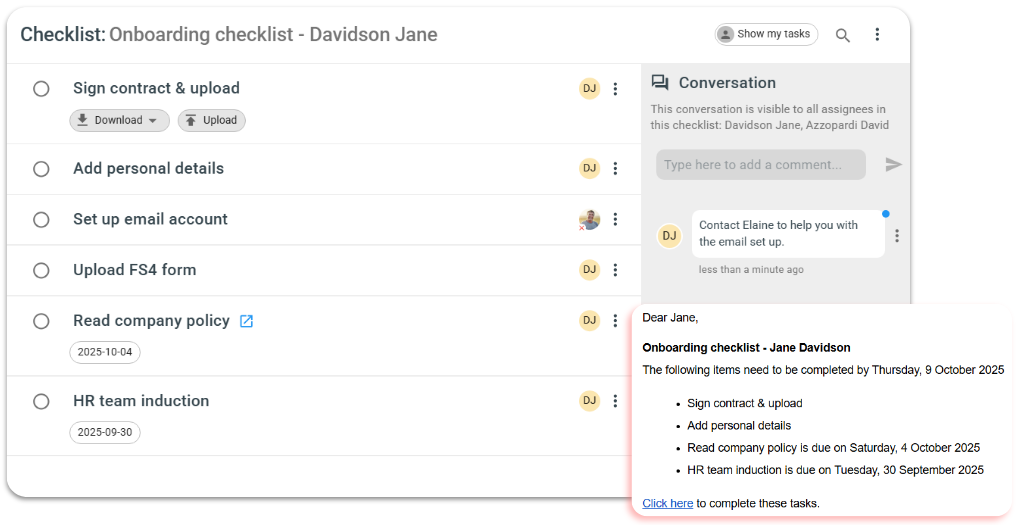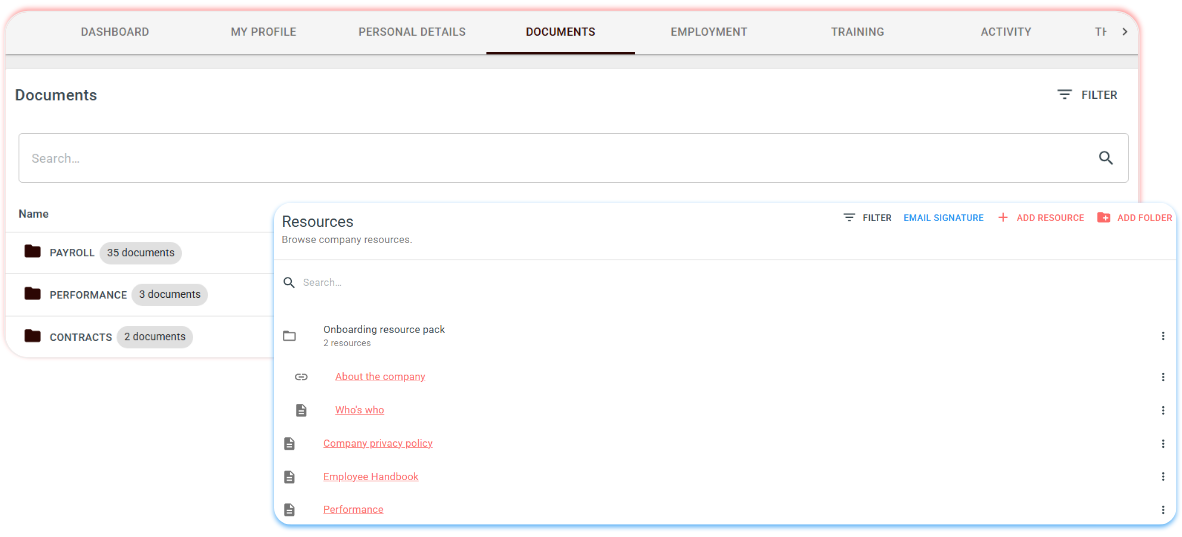Understanding why document management is important is critical for creating an employee onboarding process that is compliant, efficient and engaging. Onboarding sets the tone for the employee-employer relationship and ensures legal compliance from the very first day. Yet, HR teams often face problems such as scattered records, manual paperwork and inconsistent processes.
Only 12% of employees worldwide say their organisation does a great job onboarding new hires. In Malta, HR leaders identify time (45%), resource constraints (43%) and budget limitations (39%) as the biggest barriers to effective people practices – challenges that directly affect document management and onboarding efficiency. These figures highlight why onboarding supported by proper document management is a business-critical priority.
The Role of Document Management in Onboarding
Document management in onboarding refers to the secure, centralised handling of contracts, IDs, compliance forms, certifications and policy acknowledgements. Without effective systems, there is a higher chance of human error, data breaches and chaotic record-keeping, where physical documents end up scattered across cupboards or desks.
A digital system resolves these issues by centralising all employee documents in a single, organised platform. Documents are stored in proper data categories, and automation ensures files are categorised correctly when uploaded via onboarding checklists. Permissions can be set to control who accesses what, reducing potential compliance issues and giving HR peace of mind.
Common Challenges Without Effective Document Management
Manual paperwork often leads to inefficiency, with HR teams spending hours chasing signatures, reminding employees to submit forms and filing documents. These repetitive tasks create unnecessary delays and frustration, while also introducing compliance risks if records are incomplete or misplaced.
Without automation, onboarding processes can quickly become inconsistent. Employees may receive different instructions depending on who handles their onboarding, resulting in unequal experiences and lower confidence in the organisation. This lack of standardisation not only wastes time but can also damage the company’s image from the start.
Key Benefits of Effective Document Management
Strong document management prevents errors, ensures consistency and creates smoother onboarding for both HR and employees. Instead of looking for missing paperwork or sending endless reminders, HR teams benefit from automated workflows and clear tracking.
Consider a company in Malta where a new hire is required to provide a completed FS4 form. In the past, HR had to remind the employee to bring it, collect it manually and file it by hand. With a digital platform, this process becomes fully automated.
The HR team can create a checklist for new hires, where uploading the FS4 form is one of the tasks. Once uploaded, the system automatically allocates the document to the correct data category and saves it in the designated folder (which you have pre-automated) on the respective employee’s profile. This one-time setup means the process becomes seamless and repeatable. The result is a faster, more reliable, and less stressful onboarding experience for everyone involved.
For new employees, the benefits are just as significant. Instead of facing confusing stacks of paper, disjointed emails and unclear instructions, they get one centralised portal where all their tasks are clearly laid out. This organised, digital experience reduces anxiety, builds confidence and provides a strong first impression. For younger generations, especially those accustomed to managing their lives digitally, this has become an expectation rather than a luxury.

Get Document Management Right from Day One
Assess Current Processes
HR departments need to map every document touchpoint in the onboarding process and identify bottlenecks where errors or delays occur. This exercise often reveals how much time is wasted on repetitive manual tasks.
Implement a Digital Document Management System
Moving to a digital platform transforms how onboarding documents are managed. Instead of HR being burdened by chasing and filing missing forms, documents are stored securely, categorised automatically and available for quick retrieval. For new hires, it ensures everything is clear and accessible from their first day, making onboarding easier and more professional.
Automate Document Workflows
Automation helps standardise contracts and policies, track completion rates and speed up approvals with e-signatures. This reduces administrative overhead while ensuring nothing is missed. Studies show organisations that digitise onboarding see productivity gains of 50–60% compared to manual processes.
Ensure Data Security and Compliance
Compliance with GDPR is one of the biggest challenges companies face in managing employee documents. Manual systems leave confidential files vulnerable to breaches, while the misplacement of records increases the risk of non-compliance. Digital platforms address this through permissions, encryption, audit trails and consistent categorisation of documents. This shift reduces errors, strengthens security and ensures organisations remain compliant with strict regulations.
How can Talexio Help?
Talexio HR Essentials integrates onboarding, document storage and compliance management into one secure system. From day one, new hires have a clear, structured experience, while HR enjoys reduced administrative burdens, automated compliance checks and reliable audit trails.
Instead of outdated manual filing, HR teams gain the freedom to focus on people, strategy and culture. Employees, in turn, experience a smooth and transparent process that builds confidence from their very first day.

The Impact of Effective Document Management on HR
Adopting a paperless onboarding workflow requires a cultural and psychological shift. For HR teams, it means moving away from repetitive, paper-pushing tasks and embracing more strategic work. While some may initially fear that automation threatens their roles, the reality is the opposite: it frees them to focus on employee engagement, talent development and succession planning.
For employees, the change is about trusting digital systems with sensitive data. They need reassurance that their information is secure. At the same time, many new hires actively drive this cultural shift, expecting streamlined and modern processes. A disorganised, paper-based approach signals inefficiency, while a digital process reflects innovation, transparency and care for the employee experience.
This transformation also has a direct impact on ROI. Beyond savings on paper, storage and admin hours, the real return lies in the time reclaimed. HR staff and managers can focus less on searching for documents or updating records and more on meaningful work like mentoring, coaching and supporting their teams. The ripple effect is powerful: employees feel valued, engagement rises, productivity improves and retention strengthens. This long-term impact is a return that goes far beyond the balance sheet.
Conclusion
Understanding why document management is essential helps companies ensure compliance, efficiency and a positive onboarding experience. By adopting digital solutions like Talexio HR Essentials, organisations can streamline document handling, reduce risks and create a strong first impression that drives long-term success.






